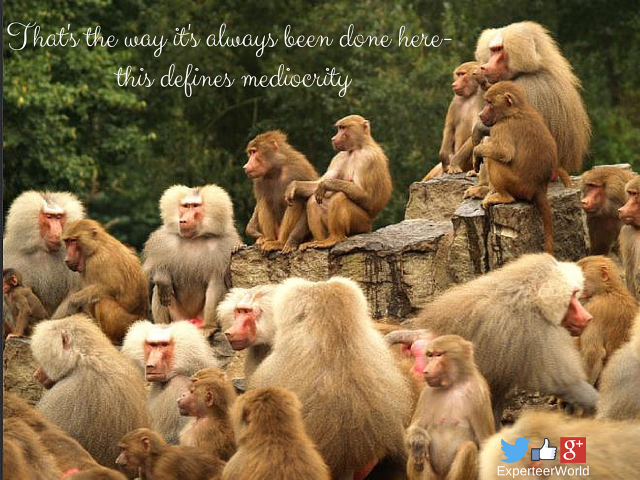Corporate Mediocrity or Meritocracy – The choice is yours! I recently read a blog by Richard Sauerman, titled ‘The Recipe for Corporate Mediocrity’. The blog details a scene where there are 5 monkeys in a cage and each needs to climb a staircase to attain a banana hanging from the roof.
Every time one of them climbs to get the prize, all of the monkeys get splashed with water, something that gets repeated till no one attempts to make the climb. On adding new monkeys to the group, the older monkeys drag him down even without being splashed.
Through this process of ongoing negative reinforcement of positive behaviors even as all of the monkeys are replaced, they continue with the taught behavior as ‘that’s the way it’s always been done around here’. This is what defines mediocrity.
Think for a moment of your team or organization at present. If asked on what do you think is mediocre – not great nor terrible, you can name a fair amount be it people, processes, entire brands or leadership.
Why is corporate mediocrity so prevalent today?
I can think of 2 main reasons for it. Firstly, on a very large scale it just goes unnoticed. If I ask you to name the top-runner in your team and the bottom-runner, most likely you will give me an answer in under a minute.
The rest fall in the good to mediocre capacity and largely fly under your radar. Secondly, mediocrity is comfortable and conformist; when everything is going steady and good why upset the apple-cart?
What leads to corporate mediocrity in a team?
Distraction
Why do you do when you are bored? People immediately think of something to distract them from the feeling of boredom. If there is no challenge being offered, most employees would look for distraction at the time they should be productively employed. Distraction is the path of least resistance, and usually leads to mediocrity.
Safety
One of the top reasons for mediocre thought is the idea of safe behaviors and decisions – follow the path that has lead to previous successes or what others are doing successfully. Leaders who follow the safe path prefer known to the unknown, thought to action, rules over guidelines, and brake over accelerator.
People who look for risk-free decisions do little beyond hiding in the comfort of their own opinions rather than seeking out dissenting opinions and fresh idea. It has become more important to do things right than do the right things.
Im-possiblity’
‘This is impossible’ – you would have heard it a fair number of times in your career. Have you passed this on to your reports on occasion too? Too often leaders filter their decisions and strategies based on ‘What is’ rather than change the lens to ‘What if’? Too often people in the top-management focus on outcomes and do not take risks or are content to stay within the set bureaucracy.
Lack of Respect
When people become invisible to a manager or leader it automatically leads to mediocrity. There are obvious prodigies in any team, but a majority of the workforce has potential which needs to perform but the inherent trust needs to be there.
When there is a lack of trust or respect, we see employees being physically present at work without getting anything done. How do you show lack of trust or respect? By not communicating decisions to them in an arbitrary manner devaluing them as team members, by playing favorites and not giving others challenging positions to prove their capability; by micro-managing every aspect of their work showing lack of trust; by making them fearful of consequences or retribution.
When leaders tolerate anything less than a person’s best effort, they do themselves and the individual a great disservice. They unknowingly set a precedent that people will accept as suitable behavior.
How do you challenge corporate mediocrity?
- Understand the organizational culture thoroughly so that you can challenge the establishment in the ways things have always been done. Refuse to accept status quo. Dismantle rigid bureaucracy and make it more flexible for people to focus on innovation over maintenance.
- Look to your entire team as being high potential employees worthy of development, investment and your attention. Teach your team to make great decisions and giving them the responsibility and authority to do so.
- Give your people the freedom to fail. If people are afraid to make mistakes, you will never see their best work. It is important for you to make a high-trust environment that rewards and recognizes people for trying new things and taking risks.





